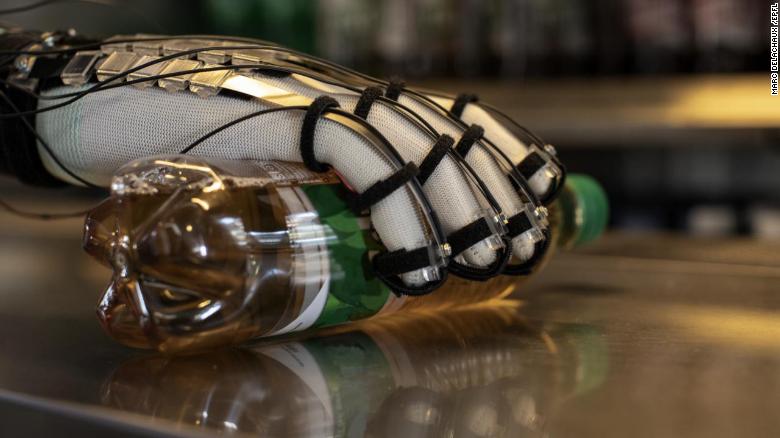(CNN)When Shaun Denis wants to relax at work, he steps into a quiet room, outfitted with a few ferns and a chair. He slips on a virtual-reality headset and a pair of noise-cancelling headphones, and escapes to the beach.
For Denis, the CEO of Ottawa, Canada-based real estate firm Umber Realty, those minutes are for solitary meditation. They're a tool he relies on regularly to both relieve and prevent stress.
He's not the only one at his company to use the room, known internally as "the retreat." The company set it up six months ago so workers could use an Oculus Go headset to watch a moon walk, take a virtual roller-coaster ride or access a meditation app.
"They just kick back for 10 or 15 minutes and come back feeling refreshed," Denis told CNN Business.
Umber Realty is among a handful of businesses, from dentist offices and airlines to spas, using virtual reality to help people chill out.
Research show VR can help reduce pain and anxiety. But it's not yet clear why it works. Experts typically believe it's related to the technology's power to distract.
"Whatever their problems are, whatever their stresses are, they can literally leave reality and have a different emotional pulse," Denis said.
Virtual reality headsets haven't taken off with consumers, but they're now powerful and inexpensive enough for companies to consider investing in them to help make workers and customers happier.
Digital nitrous
OperaVR enables dental patients to watch calming nature scenes from behind the lenses of a Pico Interactive VR headset while getting work done.
Bryan Laskin, a dentist and founder of Operability, the startup behind OperaVR, said it's used both by anxious patients and people who want to avoid the social awkwardness of having someone a few inches from their face.
Laskin claimed it also has a "profound" sedation effect on people тАФ so much so that in his dental practice VR is used far more than nitrous oxide, commonly known as laughing gas. It's plausible, as studies have shown that the technology can reduce pain for, say, burn victims during excruciating wound-care procedures.
Laskin said his dental office is one of 100 already using the technology, which costs $1,000 for each system.
"Once we have a headset on the patient, and they're relaxed, it's a better experience for everybody," Laskin said.
OperaVR lets dentists offer patients options for what to watch, such as a 3-D video of animals or a juggler. The dentist controls the video and audio via a website.
The videos, developed by Operability, range from a minute or two to as long as 20 minutes. Because dentists want patients to sit still while undergoing procedures, they don't use 360-degree imagery to ensure they won't turn their head.
In the air
Like going to the dentist, flying can cause anxiety. It can also be boring to sit in one spot for hours. To help make the time more enjoyable, some airlines are loaning first-class and business-class passengers a VR headset from startup SkyLights.
Passengers can use it to watch 2-D and 3-D movies and VR content, including 360-degree videos and some programs aimed at kids.
SkyLights CEO David Dicko, a former Air France pilot, said the company designed its own headset because it wanted passengers to have something light and comfortable enough that they could wear for a few hours at a time. SkyLights also had to sort out complicated issues, such as how the cabin crew would get the headsets to passengers, and how the headsets would be cleaned and charged.
In 2017, some smaller airlines such as XL Airways France started using the headsets on flights. Turkish Airlines, British Airways, and Alaska Airlines all introduced the technology on flights this year.
But it's not cheap. Dicko said it costs an airline somewhere between $2,000 and $3,000 per headset each year. For a single wide-body plane, the airline might need 30 to 60 headsets for all the seats in business and first class, or occasionally as many as 80 or 90 on a big aircraft. But, he said, airlines are interested because they're looking for ways to make their premium seats stand out.
Eventually, he hopes planes will offer the headsets to customers flying in economy, too.
"I love to fly as long as I'm in the cockpit but I actually don't like to fly in economy on a 12-hour flight," he said. "I don't think anybody does."
Real challenges
The headsets may help people take a virtual break from their surroundings, but there are challenges to consider. Ramon Llamas, a mobile, VR, and augmented-reality analyst at tech market researcher IDC, noted that while there aren't many businesses offering VR to customers and workers today, he eventually expects such health- and wellness-related applications to become more common.
But there could be challenges in handing out headsets. Some people get sick or dizzy while using virtual reality, and the headsets may get dirty or broken. There's also the task of quickly familiarizing people with using the headsets, especially since VR adoption has been so limited and the ways they are controlled can vary.
For now, Llamas said, he's concerned about privacy and security. What if, for instance, someone manages to hack into a headset and insert some content into what you're watching?
Another potential issue is the managing of the headsets and software that goes along with them, so that the whole system works smoothly. This is likely not a complication for an office like Umber Realty's, where people can simply take a headset off, but it could be more of a problem if you're stuck in a dentist's chair.
"The last thing you want is in the middle of a root canal something going wrong," Llamas said.







